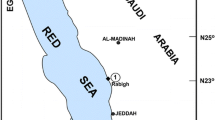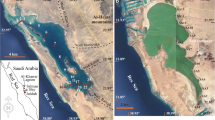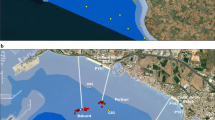Abstract
The present study investigated the natural and anthropogenic processes that control the composition of the bottom sediments of Sharm Obhur, Red Sea. Mineralogical analysis using XRD indicated that the sediments consist of carbonate and non-carbonate minerals. Elemental interrelationships allowed differentiating two groups of elements of different sources and origin. Elements that are in the same group are positively correlated, while they correlate negatively with elements of the other group. The first group includes silicon, Al, Fe, Mn, Mg, vanadium (V), chromium (Cr), Co, Ni, Cu, and Zn, whereas the other group includes Ca, Sr, and CaCO3. The highest concentration levels of the first group and the highest content of non-carbonate minerals were obtained from the sediments near the head of the sharm (zone A), whereas the sediments near the mouth of the sharm (zone B) yielded high concentrations of second group and carbonate minerals. Metal enrichment and contamination factors and pollution load index were calculated. The values of these indices differentiate two groups of metals: lithogenic and non-lithogenic. Except for lead (Pb) at one sampling site, metals in zone A sediments are of lithogenic source, supplied to the sharm either naturally by aeolian transportation and through Wadi Al-Kuraa'a during rare but major floods or by human activities such as dumping and shore protection. Non-lithogenic Cr, Pb, V, and Mn were documented from some sampling sites in zone B, and their occurrences are related to waste disposal and fossil fuel combustion.






Similar content being viewed by others
References
Abrahim, G. M. S., & Parker, P. J. (2008). Assessment of heavy metal enrichment factors and the degree of contamination in marine sediment from Tamaki Estuary, Auckland, New Zealand. Environmental Monitoring and Assessment, 136, 227–238.
Abu-Hilal, A. H. (1987). Distribution of trace elements in nearshore surface sediments from the Jordan Gulf of Aqaba (Red Sea). Marine Pollution Bulletin, 18, 190–193.
Abu-Zied, R. H., Basaham, A. S., El Sayed M. A. (2013). Effect of municipal wastewaters on surficial sediment geochemistry and benthic foraminifera of two Red Sea coastal inlets, Jeddah, Saudi Arabia. Journal of Environmental Earth Sciences, 68(2), 451–469.
Ahmad, F., & Sultan, S. A. R. (1992). The effect of meteorological forcing on the flushing of Shuaiba lagoon on the Eastern Coast of the Red Sea. Journal King Abdulaziz University Marine Science, 3, 3–9.
Ahmed, F., Bibi, M. H., Fukushima, T., Seto, K., & Ishiga, H. (2011). Recent sedimentary environment of coastal lagoon in southwestern Japan: evidence from major and trace elements. Environmental Monitoring and Assessment, 173(1–4), 167–180.
Alagarsamy, R. (2006). Distribution and seasonal variation of trace metals in surface sediments of the Mandovi estuary, west coast of India. Journal Estuarine, Coastal and Shelf Science, 67, 333–339.
Albarakati, A. M. A. (2009). Water exchange of Sharm Obhur, Jeddah, Red Sea. Journal King Abdulaziz University Marine Science, 20, 49–58.
Al-Najjar, T., Rasheed, M., Ababneh, Z., Ababneh, A., & Al-Omary, H. (2011). Heavy metals pollution in sediment cores from the Gulf of Aqaba, Red Sea. Natural Science, 3(9), 775–782.
Amorosi, A., & Sammartino, I. (2007). Influence of sediment provenance on background values of potentially toxic metals from near-surface sediments of Po coastal plain (Italy). The International Journal of Earth Sciences, 96, 389–396.
Amorosi, A., Gentineo, M. C., Dinelli, E., Lucchini, F., & Tateo, F. (2002). Geochemical variations as indicators of provenance-changes in Late Quaternary deposits of SE Po Plain. Sedimentary Geology, 151, 273–292.
Badr, N. B. E., El-Fiky, A. A., Mostafa, A. R., & Al-Mur, B. A. (2009). Metal pollution records in core sediments of some Red Sea coastal areas, Kingdom of Saudi Arabia. Environmental Monitoring and Assessment, 155, 509–526.
Basaham, A. S. (1998). Distribution and behaviour of some heavy metals in the surface sediments of Al-Arbaeen lagoon, Jeddah, Red Sea coast. Journal King Abdulaziz University Earth Science, 10, 59–71.
Basaham, A. S. (2008). Mineralogical and chemical composition of the mud fraction from the surface sediments of Al-Kharrar, a Red Sea coastal lagoon. Oceanologia, 50, 557–575.
Basaham, A. S., Rifaat, A. E., El Sayed, M. A., & Rasul, N. (2006). Sharm Obhur: environmental consequences of 20 years of uncontrolled coastal urbanization. Journal King Abdulaziz University Marine Science, 17, 129–152.
Behairy, A. K. A., El Sayed, M. K., & Durgaprasada Rao, N. V. N. (1985). Eolian dust in the coastal area north of Jeddah, Saudi Arabia. Journal of Arid Environments, 8, 89–98.
Bryan, G. W., & Langston, W. J. (1992). Bioavailability, accumulation and effects of heavy metals in sediments with special reference to United Kingdom estuaries: a review. Environmental Pollution, 76, 89–131.
Buccolieri, A., Buccolieri, G., Cardellicchio, N., Dell, A. A., Di Leo, A., & Maci, A. (2006). Heavy metals in marine sediments of Taranto Gulf (Ionian Sea, Southern Italy). Marine Chemistry, 99, 227–235.
Caeiro, S., Costa, M. H., Ramos, T. B., Fernandes, F., Silveira, N., Coimbra, A., Medeiros, G., & Painho, M. (2005). Assessing heavy metal contamination in Sado estuary sediment: an index analysis approach. Ecology Industry, 5, 151–169.
Calvert, S. E. (1976). The mineralogy and geochemistry of near-shore sediments. In J. P. Riley & R. Chester (Eds.), Chemical oceanography (p. 280). New York: Academic.
Chen, C. T., & Kandasamy, S. (2008). Evaluation of elemental enrichments in the surface sediments off southwestern Taiwan. Environmental Geology, 54, 1333–1346.
El Sayed, M. A., & Basaham, A. S. (2004). Speciation and mobility of some heavy metals in the coastal sediments of Jeddah, Eastern Red Sea. Journal of Environmental Sciences, 27, 57–92.
El Sayed, M. A., Basaham, A. S., & Gheith, A. M. (2002). Distribution and geochemistry of trace elements in central Red Sea coastal sediments. International Journal Environmental Studies, 59(1), 1–31.
El-Rayis, O. A., & Moammar, M. O. (1998). Environmental conditions of two Red Sea coastal lagoons in Jeddah: 1. Hydrochemistry. Journal King Abdulaziz University Earth Science, 9, 31–47.
Ergin, M., Kazan, B., & Ediger, V. (1996). Source and depositional controls on heavy metal distribution in marine sediments of the Gulf of Iskendrun, Eastern Mediterranean. Marine Geology, 133, 223–239.
Esen, E., Kucuksezgin, F., & Uluturhan, E. (2010). Assessment of trace metal pollution in surface sediments of Nemrut Bay, Aegean Sea. Environmental Monitoring and Assessment, 160(1–4), 257–266.
Flügel, E. (2004). Microfacies of carbonate rocks. Analysis, interpretation and application. Berlin: Springer-Verlag.
Förstner, U. (1989). Contaminated sediments. Lecture Notes on Earth Sciences. London: Springer-Verlag.
Frignani, M., Bellucci, L. G., Langgone, L., & Muntau, H. (1997). Metal fluxes to the sediments of the northern Venice Lagoon. Marine Chemistry, 58, 275–292.
Furuyama, K., Hari, K. R., & Santosh, M. (2001). Crystallization history of primitive Deccan basalt from Pavagadh Hill, Gujarat, western India. Gondwana Research, 4, 427–436.
Garver, J. I., & Scott, T. J. (1995). Trace elements in shale as indicators of crustal provenance and terrane accretion in the Southern Canadian Cordillera. Geological Society of America Bulletin, 107, 440–453.
Garver, J. I., Royce, P. R., & Smick, T. A. (1996). Chromium and nickel in shale of the Taconic foreland: a case study for the provenance of fine-grained sediments with an ultramafic source. Journal of Sedimentary Research, 66, 100–106.
Håkanson, L. (1980). An ecological risk index for aquatic pollution control. A sedimentological approach. Water Research, 14, 975–1001.
Hardy, R., & Tucker, M. (1988). X-ray powder diffraction of sediments. In M. Tucker (Ed.), Techniques in sedimentology (pp. 191–228). Oxford: Blackwell.
Hernandez, L., Probst, A., Probst, J. L., & Ulrich, E. (2003). Heavy metal distribution in some French forest soils: evidence for atmosphere contamination. Science of the Total Environment, 312, 195–210.
Heimbürger, L. E., Cossa, D., Thibodeau, B., Khripounoff, A., Mas, V., Chiffoleau, J. F., Schmidt, S., & Migon, C. (2012). Natural and anthropogenic trace metals in sediments of the Ligurian Sea (Northwestern Mediterranean). Chemical Geology, 291, 141–151.
Kieffer, B., Arndt, N., Lapierre, H., Bastien, F., Bosch, D., Pecher, A., Yirgu, G., Ayalew, D., Weis, D., Jerram, A. D., Keller, F., & Meugniot, C. (2004). Flood and shield basalts from Ethiopia: magmas from the African superswell. Journal of Petrology, 45, 793–834.
Mason, B., & Moore, C. B. (1982). Principles of geochemistry. New York: Wiley.
Morrison, R. J., Peshut, P. J., & Lasorsa, B. K. (2010). Elemental composition and mineralogical characteristics of coastal marine sediments of Tutuila, American Samoa. Marine Pollution Bulletin, 60, 925–930.
Nikolaidis, C., Zafiriadis, I., Mathioudakis, V., et al. (2010). Heavy metal pollution associated with an abandoned lead-zinc mine in the Kirki region, NE Greece. Bulletin of Environmental Contamination and Toxicology, 85(3), 307–312.
Nolting, R. F., Helder, W., Baar, H. J. W., & Gerringa, L. J. A. (1999). Contrasting behavior of trace metals in the Scheldt estuary in 1978 compared to recent years. Journal of Sea Research, 42, 275–290.
Pan, K., Lee, O. O., Qian, P., & Wang, W. (2011). Sponges and sediments as monitoring tools of metal contamination in the eastern coast of the Red Sea, Saudi Arabia. Marine Pollution Bulletin, 62, 1140–1146.
Pekey, H., Karakaş, D., Ayberk, S., Tolun, L., & Bakoğlu, M. (2004). Ecological risk assessment using trace elements from surface sediments of Izmit Bay (Northeastern Marmara Sea) Turkey. Marine Pollution Bulletin, 48, 946–953.
Preda, M., & Cox, M. E. (2005). Chemical and mineralogical composition of marine sediments, and relation to their source and transport, Gulf of Carpentaria, Northern Australia. The Journal of Marine Systems, 53, 169–186.
Prohic, E., & Yuracic, M. (1989). Heavy metals in sediments—problems concerning determination of anthropogenic influence. Study in the Krka river estuary, eastern Adriatic Coast, Yugoslavia. Environmental Geology and Water Sciences, 13, 145–151.
Radenac, G., Fichet, D., & Miramand, P. (2001). Bioaccumulation and toxicity of four dissolved metals in Paracentrotus lividus sea-urchin embryo. Marine Environmental Research, 51, 151–166.
Rifaat, A. E. (1996). Metal composition of recent carbonate sediments off Jeddah, Kingdom of Saudi Arabia. Journal King Abdulaziz University, Marine Science, 7, 133–138.
Rollinson, H. (1993). Using geochemical data: evaluation, presentation, interpretation. Longman, White Plains
Rubio, B., Nombela, M. A., & Vilas, F. (2000). Geochemistry of major and trace elements in sediments of the Ria de Vigo (NW Spain): an assessment of metal pollution. Marine Pollution Bulletin, 40(11), 968–980.
Santos, I. R., Silva-Filho, E. V., Schaefer, C. E., Albuquerque-Filho, M. R., & Campos, L. S. (2005). Heavy metal contamination in coastal sediments and soils near the Brazilian Antarctic Station, King George Island. Marine Pollution Bulletin, 50, 185–194.
Savvides, C., Papadopouluos, A., Haralambous, K. J., & Loizidou, M. (1995). Sea sediments contaminated with heavy metals: metal speciation and removal. Water Science and Technology, 32(9–10), 65–73.
Taylor, S. R., & McLennan, S. M. (1985). The continental crust: its composition and evolution. Carlton: Blackwell.
Tomlinson, D. L., Wilson, J. G., Harris, C. R., & Jeffney, D. W. (1980). Problems in the assessment of heavy metal levels in estuaries and the formation of a pollution index. Helgol Wissenschaft Meeresunters, 33, 566–572.
Tuncel, S. G., Tugrul, S., & Topal, T. (2007). A case study on trace metals in surface sediments and dissolved inorganic nutrients in surface water of Oludeniz Lagoon-Mediterranean, Turkey. Water Research, 41, 365–372.
Turekian, K. K., & Wedepohl, K. H. (1961). Distribution of the elements in some major units of the Earth's crust. Geological Society of America Bulletin, 72, 175–192.
Turki, A. J. (2007). Metal speciation (Cd, Cu, Pb and Zn) in sediments from Al Shabab Lagoon, Jeddah, Saudi Arabia. Journal King Abdulaziz University Marine Science, 18, 191–210.
Zimmermann, U., Bahlburg, H., & Esteban, S. B. (2003). Depositional history of the Ordovician Famatina Basin (Western Gondwana; NW Argentina). In G. L. Albanesi, M. S. Beresi, & S. H. Peralta (Eds.), Ordovician from the Andes (pp. 487–493). Córdoba: Comununicarte.
Acknowledgments
This project was funded by the Deanship of Scientific Research (DSR), King Abdulaziz University, Jeddah, under the grant no. 282/150/1431. The authors, therefore, acknowledge and thank the DSR technical and financial support. The authors are indebted to the anonymous reviewer and the editor for their constructive comments that improved the manuscript.
Author information
Authors and Affiliations
Corresponding author
Rights and permissions
About this article
Cite this article
Ghandour, I.M., Basaham, S., Al-Washmi, A. et al. Natural and anthropogenic controls on sediment composition of an arid coastal environment: Sharm Obhur, Red Sea, Saudi Arabia. Environ Monit Assess 186, 1465–1484 (2014). https://doi.org/10.1007/s10661-013-3467-x
Received:
Accepted:
Published:
Issue Date:
DOI: https://doi.org/10.1007/s10661-013-3467-x




